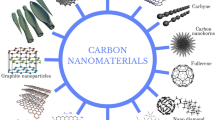Abstract
Liquid-phase exfoliation (LPE) is a promising technique for commercializing graphene production because of its simplicity and cost-effectiveness. However, the low yield of graphene in laboratory-scale production, less than 10 g/h, necessitates modifications to the process for it to be feasible for commercial applications. Natural graphite has various size distribution, crystallite sizes, and interlayer space, making the choice of initial graphite very important. Five types of natural graphite with different structures were prepared for the experiment. The structural parameters of graphite such as crystallite size and d-spacing were precisely determined based on a standard procedure of X-ray diffraction measurements for carbon materials. The effects of graphite flake size and crystallite size on the productivity and quality of few-layer graphene (FLG) were investigated. The results showed that small graphite was easier to fragment and exfoliate. FLG productivity improvement up to 1500% was attained when graphite with smaller flakes was used instead of graphite with large flakes. The crystallite size of graphite was manipulated by plenary ball milling, and the effect of crystallite on FLG productivity in LPE process was also discussed.







Similar content being viewed by others
References
Kelly AG, Hallam T, Backes C, Harvey A, Coleman JN et al (2017) All-printed thin-film transistors from networks of liquid-exfoliated nanosheets. Science 356:69–73
Bonaccorso F, Colombo L, Yu G, Stoller M, Tozzini V et al (2015) Graphene, related two-dimensional crystals, and hybrid systems for energy conversion and storage. Science 347(6217):1246501
Boland CS, Khan U, Ryan G, Barwich S, Charifou R et al (2016) Sensitive electromechanical sensors using viscoelastic graphene-polymer nanocomposites. Science 354:1257–1260
Liu Z, Parvez K, Li R, Dong R, Feng X et al (2015) Transparent conductive electrodes from graphene/PEDOT:PSS hybrid inks for ultrathin organic photodetectors. Adv Mater 27:66–675
Young RJ, Kinloch IA, Gong L, Novoselov KS (2012) The mechanics of graphene nanocomposites: a review. Compos Sci Technol 72:1459–1476
Stankovich S, Dikin DA, Piner RS, Kohlhaas KA, Kleinhammes A et al (2007) Synthesis of graphene-based nanosheets via chemical reduction of exfoliated graphite oxide. Carbon 45:1558–1565
Parvez K, Wu ZS, Li R, Liu X, Graf R et al (2014) Exfoliation of graphite into graphene in aqueous solutions of inorganic salts. J Am Chem Soc 136:6083–6091
Pénicaud A, Drummond C (2013) Deconstructing graphite: graphenide solutions. Acc Chem Res 46:129–137
Hernandez Y, Nicolosi V, Lotya M, Blighe FM, Sun Z, De S et al (2008) High-yield production of graphene by liquid-phase exfoliation of graphite. Nat Nanotechnol 3:563–568
Halim U, Zheng CR, Chen Y, Lin Z, Jiang S et al (2013) A rational design of cosolvent exfoliation of layered materials by directly probing liquid–solid interaction. Nat Commun 4:2213
Shen J, He Y, Wu J, Gao C, Keyshar K et al (2015) Liquid phase exfoliation of two-dimensional materials by directly probing and matching surface tension components. Nano Lett 15:5449–5454
Shen J, Wu J, Wang M, Dong P, Xu J et al (2016) Surface tension components based selection of cosolvent for efficient liquid phase exfoliation of 2D materials. Small 12:2741–2749
Arao Y, Mori F, Kubouchi M (2017) Efficient solvent systems for improving production of few-layer graphene in liquid phase exfoliation. Carbon 118:18–24
Paton KR, Varrla E, Backes C, Smith RJ, Khan U, O’Neill A et al (2014) Scalable production of large quantities of defect-free few-layer graphene by shear exfoliation in liquids. Nat Mater 13:624–630
Arao Y, Mizuno Y, Araki K, Kubouchi M (2016) Mass production of high-aspect-ratio few-layer graphene by high-speed laminar flow. Carbon 102:330–338
Karagiannidis PG, Hodge SA, Lombardi L, Tomarchio F, Decorde N et al (2017) Microfluidization of graphite and formulation of graphene-based conductive inks. ACS Nano 11:2742–2755
Iwashita N, Park CR, Fujimoto H, Shiraishi M, Inagaki M (2004) Specification for a standard procedure of X-ray diffraction measurements on carbon materials. Carbon 42:701–714
Aso H, Matsuoka K, Sharma A, Tomita A (2004) Structural analysis of PVC PFA carbons prepared at 500–1000°C based on elemental composition, XRD, and HRTEM. Carbon 42:2963–2973
Podila R, Anand B, Spear JT, Puneet P, Philip R et al (2012) Effects of disorder on the optical properties of CVD grown polycrystalline graphene. Nanoscale 4:1770–1775
Yu Q, Jauregui LA, Wu W, Colby R, Tian J et al (2011) Control and characterization of individual grains and grain boundaries in graphene grown by chemical vapor deposition. Nat Mater 10:443–449
Bandenhorst H (2014) Microstructure of natural graphite flakes revealed by oxidation: limitations of XRD and Raman techniques for crystallinity estimates. Carbon 66:674–690
Dimiev AM, Tour JM (2014) Mechanism of graphene oxide formation. ACS Nano 8:3060–3068
Bacon GE (1951) The interlayer spacing of graphite. Acta Cryst 4:558–561
Feng H, Cheng R, Zhao X, Duan X, Li J (2013) A low-temperature method to produce highly reduced graphene oxide. Nat Commun 4:1539. https://doi.org/10.1038/ncomms2555
Khan U, O’Neill A, Lotya M, De S, Coleman JN (2010) High-concentration solvent exfoliation of graphene. Small 6:864–871
Khan U, O’Neill A, Porwal H, May P, Nawaz K, Coleman JN (2012) Size selection of dispersed, exfoliated graphene flakes by controlled centrifugation. Carbon 50:470–475
Bonaccorso F, Bartolotta A, Coleman JN, Backes C (2016) 2D-crystal-based functional inks. Adv Mater 28:6136–6166
Acknowledgements
This work was supported by JSPS KAKENHI Grant Number 15H05504 and the Fujikura Foundation. The authors acknowledge the Center for Advanced Materials Analysis in Tokyo Institute of Technology for the XRD and Raman analysis. We wish to acknowledge Jonathon Tanks for his help in English editing.
Author information
Authors and Affiliations
Corresponding author
Electronic supplementary material
Below is the link to the electronic supplementary material.
Rights and permissions
About this article
Cite this article
Mori, F., Kubouchi, M. & Arao, Y. Effect of graphite structures on the productivity and quality of few-layer graphene in liquid-phase exfoliation. J Mater Sci 53, 12807–12815 (2018). https://doi.org/10.1007/s10853-018-2538-3
Received:
Accepted:
Published:
Issue Date:
DOI: https://doi.org/10.1007/s10853-018-2538-3




